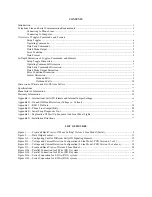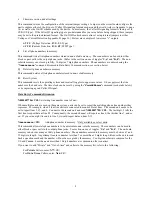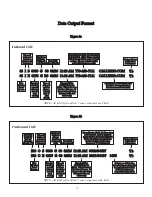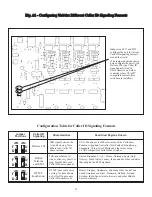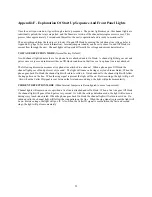
9
Wnn <CR>
Block (or pass) call on line
nn *
Only available on select units.
This command should be sent after the Caller ID signal and before the second ring. This way the call can be
blocked (or passed) based on the Caller ID information. If toggle "
B
" is set, the first ring will be blocked. The
application program determines whether the remaining rings should be blocked or passed. Please note: Normally,
toggle "
K
" is set. This allows all calls to pass until a "
W
" is sent by the application (or an internal command is sent
by the hardware memory). In a secure phone line application, the toggle "
k
" might be set in order to block all calls
until the "
W
" command is sent (or the internal command is sent by the hardware memory).
Zmmddhhmm <CR>
Set date and time on internal clock
This allows the programmer to set the internal clock on the unit. Since there is no battery backup on board, once
power is removed from the unit, the internal clock resets to "00/00 00:00:00". This command may never have to be
used, due to the following: On the first incoming call with Caller ID and a good checksum, the internal time clock
will be set to the time sent in the Caller ID signal. On every call thereafter, the internal clock is reset to the Caller
ID time. The format for time entry using the "
Z
" command is
mm
(month),
dd
(day),
hh
(hour), and
mm
(minute).
Detail Mode Output Discussion
If the toggle "
d
" is set, all detail information on each call is sent immediately. The detail events include Ring, On
Hook, Off Hook, and Hook Flash. Each event reported by the unit starts with the line number, followed by the
abbreviation of the event, and finally, the date and time. The date and time is offset 13 characters to the right so that
it will appear in the same offset position as the date and time in the comprehensive format. Also, the time is
displayed in a military format so that the time of the event can be determined exactly. An example is shown below.
01
R
11/07
07:43:52
Ringing on line 1 at 7:43 AM
01
F
11/07
17:45:04
Off Hook on line 1 at 5:45 PM
04
N
11/07
10:46:23
On Hook on line 4 at 10:46 AM
Error Condition Discussion
A question mark (
?
) is returned on most any input that is not valid. Also, any non-interpretable characters contained
within a Caller ID string will be sent as a question mark. Most likely the checksum will be calculated as "bad".
Format Discussion
Inbound Calls
The format for an inbound call is shown in Fig. 2a. The data string can be, 63 characters in length, including the
leading
$
sign (if the "
c
" toggle is set), spaces, the carriage return, and line feed characters at the end of the data.
The line number always precedes the data string. In this example, data from line 3 is discussed.
The Inbound/Outbound and Start/End of Call Indicators use I/O and S/E respectively. Remember that the unit can
be set to send data on inbound and outbound calls or only on inbound calls (toggle "
O,o
"). Also, the data stream
can be sent at the start of the call, end of the call, or both (see toggles "
A,a
" and "
S,s
").
Since the duration of the call is sent only after the call is complete, toggles "
O,o
" and "
S,s
" must be set so the unit
will send data at the end of the call.
The Caller ID string sent by the telephone company always contains a checksum. The unit compares its checksum
with the checksum sent by the phone company and displays the either "G" (Good) if the two match or "B" (Bad) if
they do not match. The application programmer may elect to ignore this indicator and determine the validity of the
data after reading in the data stream.
The next field contains both the number of rings delivered by the telephone company before the call was answered
and the type of ring. A service called Distinctive Ring or Ring Master is offered to customers in many areas. It
allows up to 4 telephone numbers to be routed to one phone line. Each phone number dialed causes the telephone to



